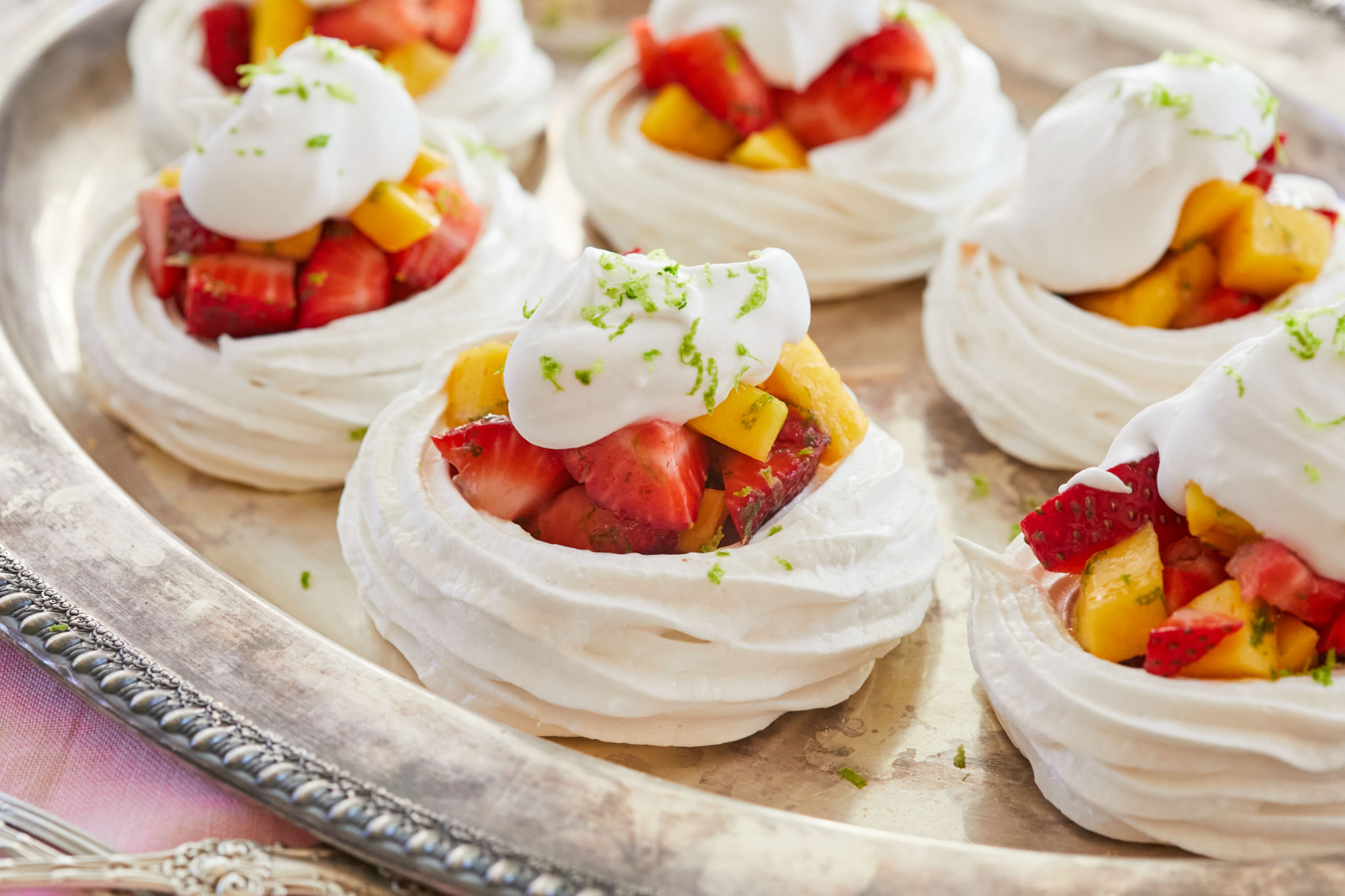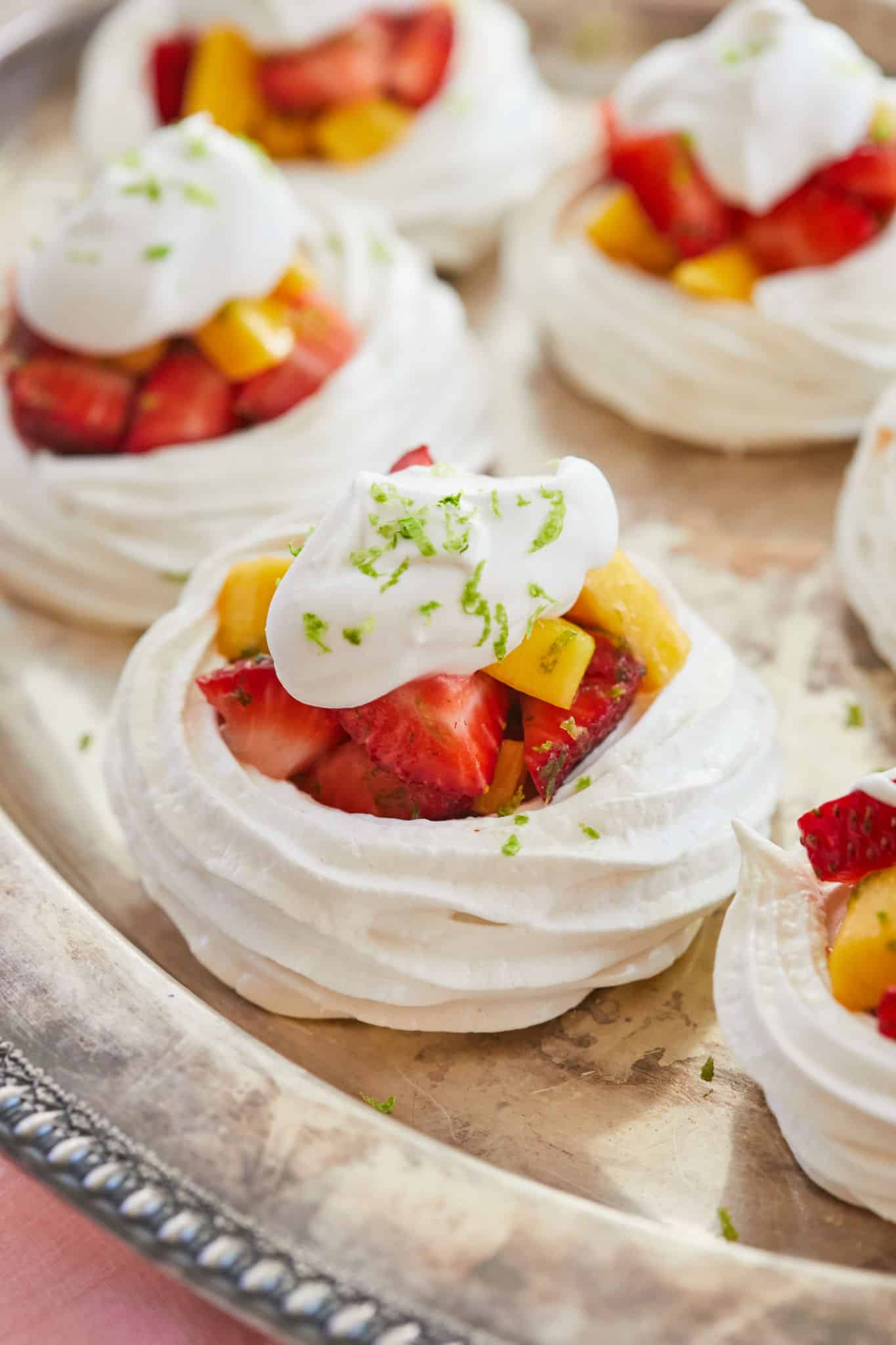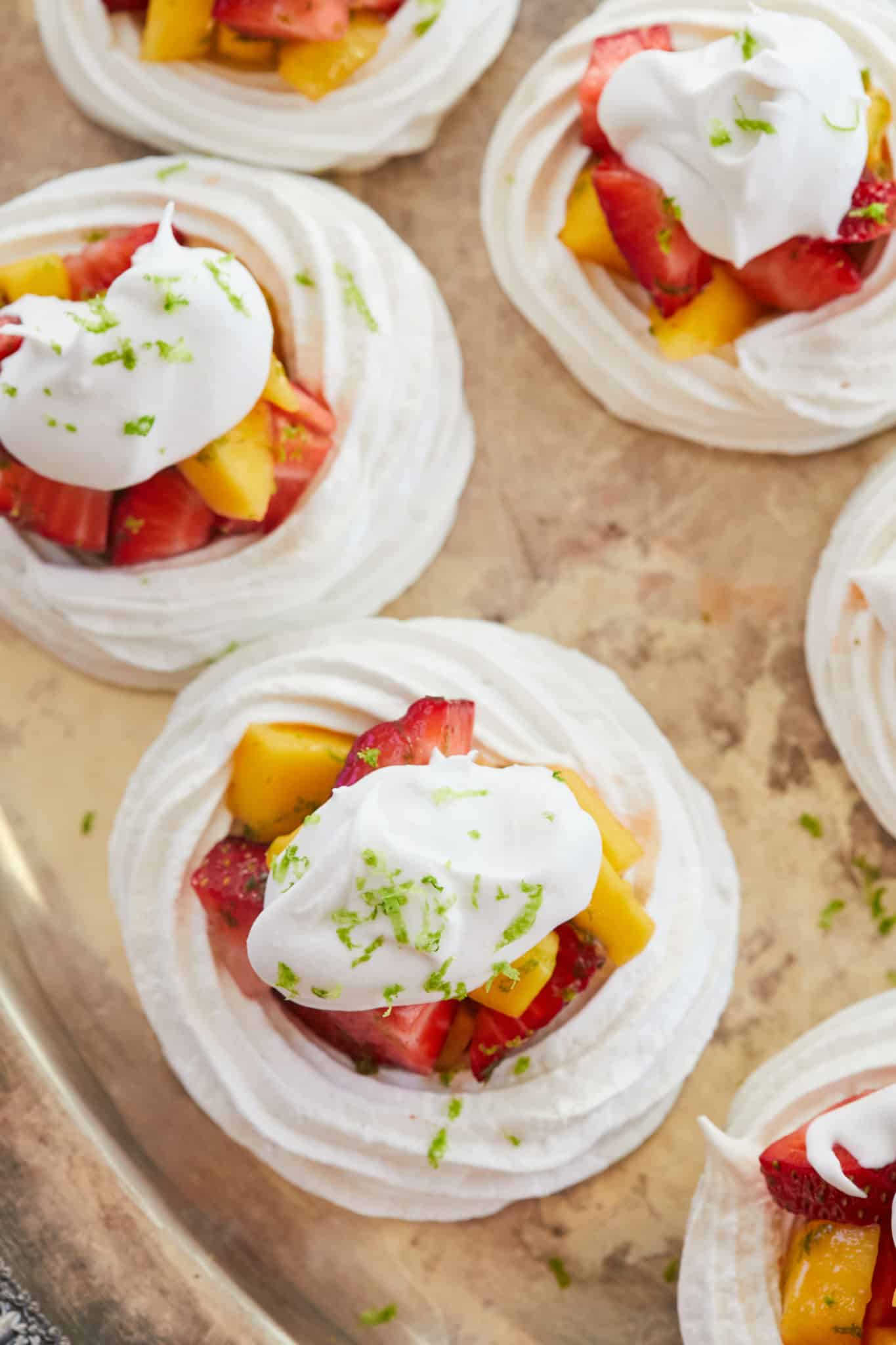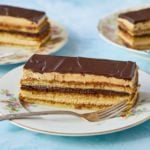
This post may contain affiliate links. Please see my full disclosure for details.
Hi Bold Bakers!
WHY YOU’LL LOVE THIS RECIPE: These stunning, Heavenly Meringue Nests seamlessly combine crispy and airy meringue with the sweetness of fresh tropical mangos and strawberries, all crowned with silky, light coconut cream. The delightful medley brings you a satisfying cohesion of textures and flavors in every delectable bite.
Meringue-based dessert is absolutely hands-down my favorite sweets of all time! It’s something that I had a lot growing up in Ireland. Meringue nests are similar to Pavlova but even more elegant. After years of dedicated practice driven by passion, I am proud to confidently declare that you will master the art of creating flawless meringue nests using my straightforward techniques every time!
Table of Contents
- What are Meringue Nests?
- Tools for Meringue Nests
- Key Ingredients for Meringue Nests and Why
- Can I make Meringue Nests Ahead of Time and How to Store Meringue Nests?
- What Can I Substitute for Egg Whites in Meringue Nests to Make Them Vegan-Friendly?
- FAQs
- Gemma’s Pro Chef Tips
- More Meringue-Based Desserts

What are Meringue Nests?
- A meringue nest is a sweet dessert component made from egg whites and sugar, typically baked until crisp on the outside and soft on the inside. It features a delicate and airy texture and is commonly used as a base or vessel for holding other dessert elements.
- Meringue nests are often shaped like small cups or bowls, which makes them perfect for filling with various sweet toppings like fresh fruits, whipped cream, vanilla ice cream, custard, or fruit coulis.
- This recipe replaced whipped cream with whipped coconut cream to make it dairy-free and enjoyable for more people.
Tools for Meringue Nests
- Measuring cups and measuring spoons
- Electric stand mixer or hand mixer
- Mixing bowls
- Spatula
- Baking trays
- Parchment paper
- Piping bag or pastry bag
- Star nozzle
Key Ingredients for Meringue Nests and Why
-
Egg whites (What do egg whites do in meringue nests?)
- Egg whites play a crucial role in meringue nests:
- Egg whites contain proteins which denature and re-group when beaten, creating a network to trap and retain air to form an aerated structure for meringue. In addition, egg whites also have a small amount of water to bind proteins and aid in the network formation.
- The proteins in egg whites coat the air bubbles to prevent them from collapsing. This helps stabilize meringue’s structure.
- Whipping up egg whites incorporate air which will expand in the oven heat, causing the meringue mixture to rise to a light texture.
- Note to use room-temperature egg whites which whip up very well.
- Use egg yolks in these delicious recipes of mine: Creamy Coconut Custard Tart With Pâte Sucrée, Southern Egg Custard Pie, Lemon Curd, and more!
- Egg whites play a crucial role in meringue nests:
-
Sugar (What does sugar do in meringue nests?)
- Sugar sweetens meringue nests, balancing the natural flavor of egg whites.
- When sugar is beaten into an egg-white foam, it dissolves in the protein film on the surface of the air bubbles.
- This sugary syrup film prevents the proteins from drying out and tightening up too fast, helping maintain the volume of baked meringue.
- In addition, sugar on the surface of air bubbles caramelizes during baking, contributing to the crispiness and browning which adds color and flavor to meringue.
- At the same time, sugar attracts and locks in moisture to keep the interior of meringue tender.
- Sugar substitutes tend to yield different results. Allulose will work close to sugar.
-
Cornstarch (What does cornstarch do in meringue nests?)
- Cornstarch is a stabilizer because its molecules absorb excess moisture preventing meringue from weeping.
- Cornstarch molecules swell from absorbed water forming a gel network, which binds proteins and components cohesively to create a smoother and finer texture.
-
White vinegar or lemon juice (What does vinegar or lemon juice do in meringue nests?)
- Vinegar or lemon juice stabilizes the meringue and improves its texture.
- Because an acidic environment can promote the denaturation and bonding of protein, resulting in a more stable and finer meringue.
-
Coconut cream
Coconut cream adds a natural sweetness to meringue nests and is a great dairy-free and vegan-friendly substitute for whipped cream.
- Full-fat coconut cream can be whipped up because of its high fat content and proteins that can incorporate and retain air.
- Additionally, coconut cream also contains emulsifier to stabilize the structure.
- To successfully whip up coconut cream, it needs to be properly chilled at least overnight to solidify and become more stable.
-
Strawberry, Mango and Lime (What other fruits go well with meringue nests?)
- This combination pairs perfectly with coconut cream with a refreshing tropical note and vibrant color contrast.
- Feel free to customize the topping with other seasonal fruits such as pineapple, pears, apricot, pink grapefruit, cherry, melon and any of your favorites!
How to Make Meringue Nests with Mango, Strawberry, and Dairy-Free Coconut cream
-
Making the meringue nests
-
- Line 2 baking trays with parchment paper and set aside.
-
Follow my recipe for Pavlova Master Recipe to make the meringue base. (Or use store-bought meringues.)
-
Start whipping egg whites in a clean bowl (no water, no grease) for 2 minutes on LOW speed until bubbles start to form.
-
Turn the machine up to medium-high speed and continue whipping until the egg whites start to reach soft peaks, roughly 2-3 minutes.
-
In a small bowl add the sugar. To this add cornflour and the vinegar. (see video for step by step instruction)
-
Slowly start to add the sugar 1 tablespoon at a time until it is all incorporated and egg whites double in volume and get shiny. Continue whisking for 2 more minutes and then turn off the machine.
-
-
Fit a pastry bag with a medium star nozzle and pipe a rouglhy 3 inch circle on the baking trays. Go around the circumfrance of the circle and build another 1-2 layers ontop of that to make your meringue nest.
-
Bake the meringues at 225°F (115°C) for roughly 1 ½ hours or until they easily remove from the baking sheet. Do NOT brown the meringue.
-
Set aside to cool down at room temperature until you are ready for them.
Assembling the Meringue Nests with Mango, Strawberry, and Dairy-Free Coconut cream
-
Macerate strawberry chunks and mango chunks with lime zest and juice for roughly 1 hour to meld flavors.
-
Remove the cans of coconut cream from the fridge. Turn the cans upside-down and pour off the water leaving you with just the coconut solids. (Watch video 0:36-1:22 to see the trick!)
-
Whip the coconut cream until smooth and thickened.
-
Generously spoon the fruit salad into your meringue nests and add whipped coconut cream ontop.
-
Serve within 3 hours of assembly. These are best enjoyed the day they are assembled.
Can I Make Meringue Nests Ahead of Time and How to Store Meringue Nests?
Yes, you can make meringue nests in advance. The best way to store meringue nests is to prepare and store components separately.
- You can store completely-cooled baked meringue in an airtight container in a cool, dry place at room temperature. I do not recommend you refrigerate meringue as moisture in the fridge can cause meringue to get soggy and loose it texture.
- Whip up chilled coconut cream before serving for the best result.
- You can macerate fruit with citrus zest and juice for at least 1 hour up to three days before serving for the best flavors. Keep leftover macerated fruit in an airtight container in the fridge.
What Can I Substitute for Egg Whites in Meringue Nests to Make Them Vegan-friendly?
- Yes, you can make a light-as-air yet vegan-friendly meringue base for meringue nests using my Vegan Meringue Recipe.
- Don’t forget to check out The Complete Guide to Aquafaba to utilize this amazing egg substitute in baking!
FAQs
How can I flavor the meringue for meringue nests?
- You can incorporate thickened fruit purée into meringue referring to my recipe of Raspberry Meringue With Pistachio.
- To be even more creative, you can experiment with extracts, citrus zest, spices such as cinnamon, nutmeg or cardamom, matcha powder, cocoa powder or finely grated chocolate, coffee or espresso powder, finely chopped herbs like mint, basil, lavender, or toasted nuts.
Why did meringue nests weep and how can I avoid that?
Meringue is full of sugar which absorbs moisture to make meringue weep. To avoid this from happening:
- Use fresh eggs which contain less excess moisture than old eggs.
- Make sure to use clean tools which are grease-free and have no water or dirt. So nothing will interrupt the meringue structure during whipping.
- Take care not to over whip egg whites which make meringue dry and grainy. Watch my video carefully and whip up egg whites until double in size and shiny.
- Using cornstarch in meringue can also absorb excess moisture and stabilize the structure.
Why did meringue nests crack and how can I avoid meringue cracking?
Meringue can crack for various factors during preparing, baking, and cooling process. Here’s how to avoid it:
- Lacking stabilizers such as vinegar, lemon juice or corn starch can weaken the meringue’s structure. Use the correct amount of ingredients per the recipe.
- Over-whipping or under-whipping can’t provide meringue a stable structure. Start it on low until the egg whites start to foam and begin forming bubbles. Then turn up the speed and whip to soft peaks to give the egg whites time to stabilize to hold sugar. Continue to whip with sugar until stiff peaks. (Be sure to check out my article on How to Whip up Egg Whites Properly. )
- Over-baking can make meringue exterior too dry which is prone to cracking. Baking at a low temperature for a long time is the key.
- Under-baking gives meringue a soft exterior that’s not strong enough to hold the shape.
- Rapid temperature changes can cause meringue to contract too quickly and then crack. After baking time, you can leave the meringue to cool and dry out in the oven for 3 hours or overnight.
What’s the difference between meringue nests and pavlova?
In summary, while both meringue nests and pavlovas share a similar base of meringue, they mainly differ in their size, shape, texture, presentation, and the context in which they are typically served.
- Origin:
- Meringue Nests are common in various cuisines.
- Pavlova came from either Australia or New Zealand, and is believed to be named after the Russian ballet dancer Anna Pavlova to honor her graceful performance there in 1920s .
- Texture and Shape:
- Meringue Nests are a small, individual-sized dessert made by piping or shaping meringue into bowls. It typically has a crisp outer shell and a soft, marshmallow-like interior.
- Pavlova is a larger dessert that is often baked in a single round or oval shape, creating a crispy outer shell with a soft and slightly chewy interior. It has a meringue base that is higher and more substantial than a meringue nest.
- Size and Serving:
- Meringue Nests are usually smaller and individual-sized.
- Pavlovas are larger and often presented as a centerpiece dessert.
- Presentation:
- Meringue Nests provide wells for holding various toppings, such as creams, fruits, and sauces, offering a visually appealing dessert.
- Pavlovas are typically adorned with a thick layer of whipped cream and a colorful arrangement of fresh fruits on top. The presentation is elegant and artistic, showcasing the beauty of the ingredients.
Gemma’s Pro Chef Tips
- Do you bake a lot and have a supply of egg whites? Freeze those puppies in ziplock bags, label them and then defrost and use for future meringue and pavlova desserts.
- With the leftover coconut water you have in the can once you remove the solids you can add to curries or even smoothies.
- Pipe and bake your meringues days in advance so you have them ready and all you have to do is assemble. They keep for days in an airtight container at room temperature.
- If you struggle with piping then feel free to dollop the meringue on the tray with a spoon and make a dent in the middle for the fruit and cream to go.
More Meringue-Based Desserts
Heavenly Meringue Nests with Mango, Strawberry and Dairy-Free Coconut Cream
Ingredients
- 1 Pavlova Master Recipe
- 10 strawberries
- 1 large mango
- 1 medium lime
- 2 cans Cococnut Cream (keep in the fridge)
Instructions
Making the Meringues
- Follow my recipe for Pavlova Master Recipe to make the meringue base. Line 2 baking trays with parchment paper and set aside.
- Fit a piping bag with a medium star nozzle and pipe a rouglhy 3 inch circle on the baking trays. Go around the circumfrance of the circle and build another 1-2 layers ontop of that to make your meringue nest. (If you struggle with piping then feel free to dollop the meringue on the tray with a spoon and make a dent in the middle for the fruit and cream to go)
- Bake the meringues in a low oven at 225°F (115°C) for roughly 1 ½ hours or until the easily remove from the baking sheet. The meringues should not get brown during this process but more so dry out. Set aside to cool down at room temperature until you are ready for them.
Assembling the Meringues
- Chop up the strawberries and mango into chunks and place in a small bowl. Add the zest of a lime and 1 tablespoon of juice. Set aside to mascerate for roughly 1 hour
- Remove the cans of coconut cream from the fridge. Open and pour off the water leaving you with just the coconut solids. (reserve the coconut water for smoothies or making curries)
- Place the solids in a mixing bowl and whip the coconut cream until smooth and thickened. You can do this by hand or by using an electric hand mixer.
- Generously spoon the fruit salad into your meringue nests and add a big dollop of the coconut cream ontop. Serve within 3 hours of assembly. These are best enjoyed the day they are assembled.







